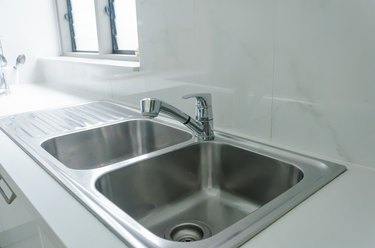
When a kitchen sink gets clogged up, it's usually because grease and starches have hardened in the pipes and are catching larger debris. If you can remove some of the larger debris to allow water to flow, you're well on the road to clearing the pipe. Plunging is usually the best way to do this, but if you're looking for something even easier, try a Zip-It tool. This is an inexpensive, barbed ribbon of plastic similar to a cable tie, and it's available at any hardware store.
You won't be able to use a Zip-It tool or a snake if your slow draining sink has a garbage disposal. In that case, after you've found plunging ineffective, you might want to resort to chemicals. But it's a good idea to stay away from caustic drain cleaners, which can actually be dangerous if you pour them in the garbage disposal. A baking soda and vinegar volcano often works, but if not, you'll probably have to disassemble and clean the P-trap.
Video of the Day
Video of the Day
What's the Best Way to Unclog a Kitchen Sink?
Plunging is far and away the best way to clear any type of sink, as long as you do it properly. First, for the plunger to develop sufficient force to dislodge debris, it must be the right type. A sink plunger is small and dome-shaped, not bell-shaped (that's for toilets), and it must be large enough to completely cover the drain opening.
Second, a plunger works best if there is water in the sink. If the kitchen sink is not draining, all you have to do is turn on the faucet. But if the sink is draining slowly, you might need to close the stopper to allow the sink to fill with about 2 inches of water. Once the sink has some standing water, you're ready to take the plunge.
Hold the plunger in the bottom of the sink and tilt it slightly to let bubbles escape so you're plunging with air, then cover the drain opening and pump vigorously. Keep going until water starts draining more quickly. Nine times out of 10, you'll be successful.
Reach into the Drain and Pull Out the Clog
You can't, of course, reach into the drain with your hand, so you need a tool. If the drain has a basket strainer, try a Zip-It tool. It catches all sorts of debris, especially the fibrous type, such as hair and fibrous vegetables like celery and asparagus. That's why it's also a great tool to use if your old or new bathroom sink drains slowly.
If you're in too much of a hurry to go to the hardware store, try poking through the clog with a straightened out coat hanger or, if you have one, a 2-foot length of spare electrical cable. You can also use a sink auger, or snake, if you have one in your tool chest.
Try the Drain Volcano
If the slow draining sink has a garbage disposal, or you prefer to clear it with chemicals from the start, pour in 1/2 cup of baking soda and follow this with about 1/2 gallon of a 50/50 mixture of vinegar and boiling water. The mixture creates a cleansing foam that can dislodge most of the debris so that it washes away when you pour in more boiling water about 10 minutes later. Be sure to run the garbage disposal before you do this to make sure the blockage isn't in the disposal.
If the volcano doesn't work, the last resort is to disassemble the P-trap and physically clean it out. It's a messy job, but it's one almost anyone with a pair of locking pliers can do. Clear out the sink cabinet first and get a bucket because things will get messy before they get better.